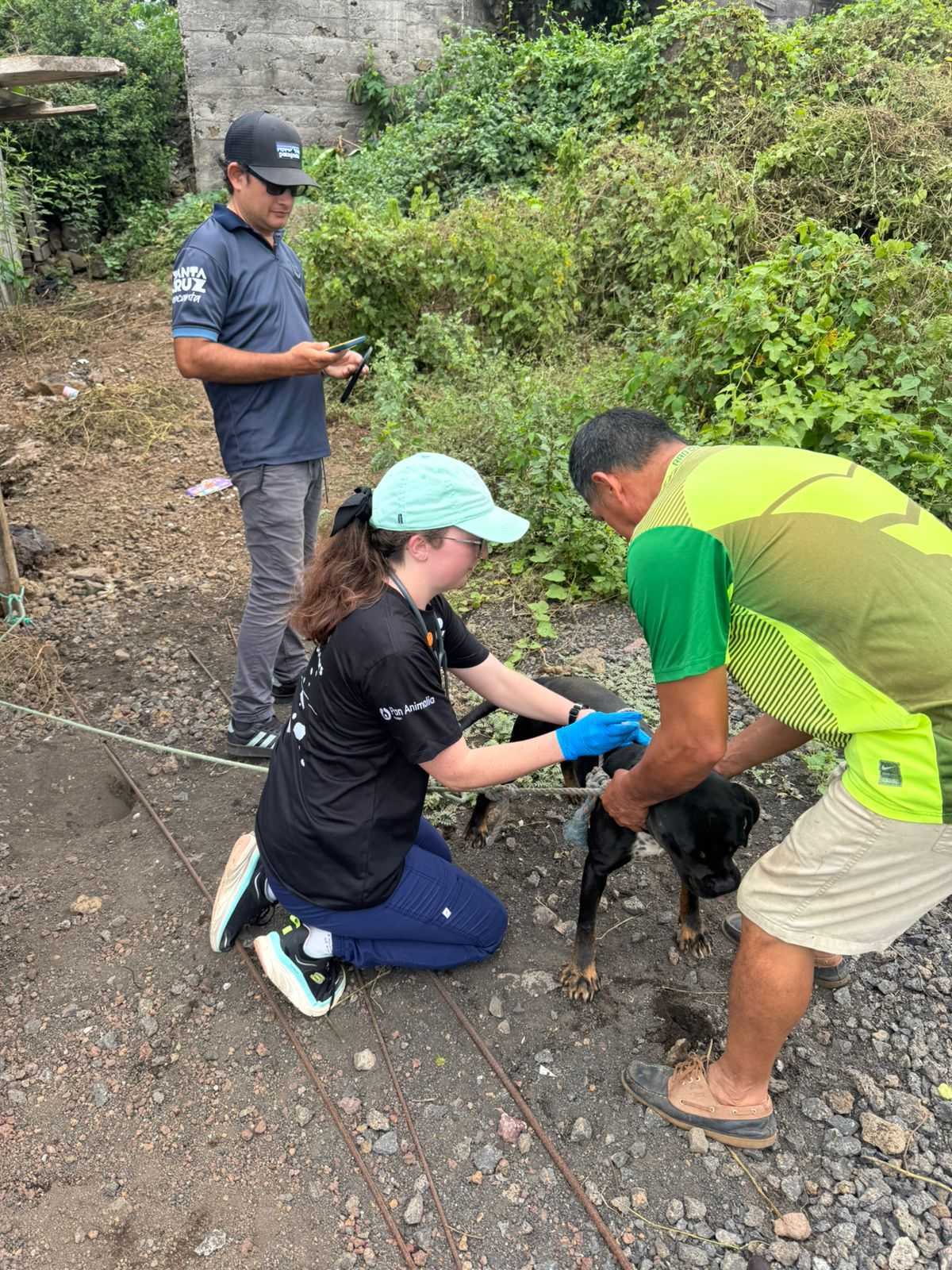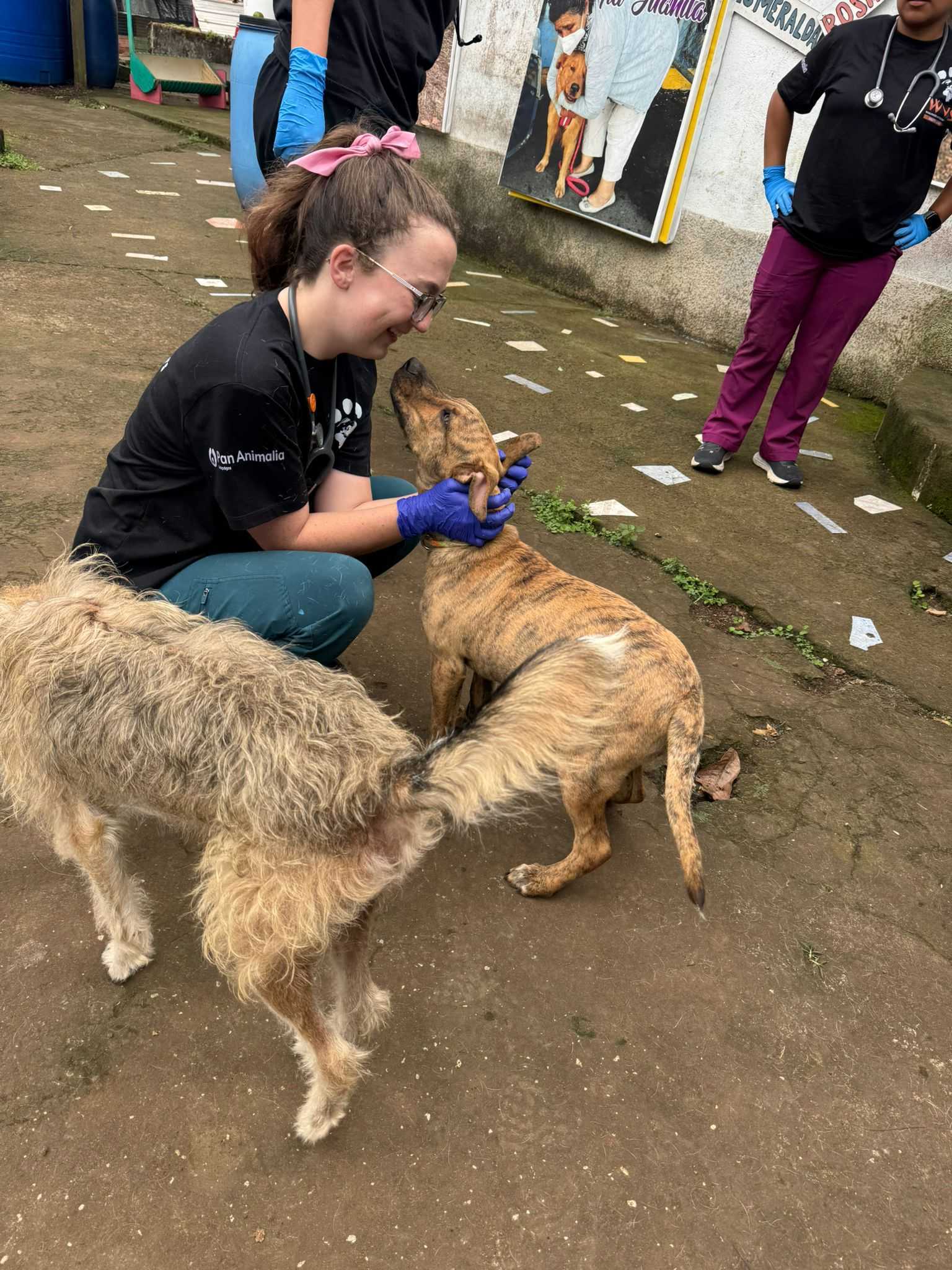The author, Katrina Pope, works with a dog and its owner while in the Galapagos

The author, Katrina Pope, vaccinates a dog as their owner watches while she works in the Galapagos
Two weeks on a beautiful island, getting to explore while learning more about the career I love? What’s not to love?
That was the opportunity presented to me at school, a unique program run by Worldwide Veterinary Services (WVS). I traveled down to Santa Cruz Island in the Galapagos to work with the Pan Animalia team there. For two weeks, I acted as a member of the team. During the day, I helped with consultations and surgeries. In the evenings, I explored Puerto Ayora. In a few days, I visited shelters and helped with vaccine clinics.
I had worked at several clinics before, but hadn’t seen anything quite like this. We used plastic wrap to create makeshift oxygen cages. We administered vaccines by going from house to house, using a fanny pack as a sharps container and a cooler as our workspace. We sent the patients that needed X-rays to a human clinic to borrow their equipment. However, the quality of medicine they managed to practice was still excellent. We used sliding doors to create a sterile room for surgery. An ultrasound probe could be moved around the rooms to scan urgent issues in patients. A stethoscope was used for anesthetic monitoring, replacing several pieces of fancy equipment.
The workflow was different, too. They had three doctors, one technician, one manager, and several students floating around. The doctors were used to working independently, doing their own diagnostics, treatments, and restraints. Tools were limited, forcing them to rely on a good examination over diagnostic tests. It wasn’t like what I learned at school, but I could see the impact it had on the community.
A year before that trip, I had attended lectures by the ASPCA on community medicine. While there, they discussed what gold standard medicine means and how it can sometimes hurt our relationship with clients. The idea of a gold standard is often used to imply some perfect medicine we might all practice if only we were allowed to do so, with some people using it to shift the blame to owners, managers, or other staff who don’t live up to what they desire. However, what does perfect medicine mean?
In the Galapagos, bloodwork was not standard for all surgeries. We didn’t have T-ports for all catheters. Bags of fluids were reused between patients. Radiographs weren’t often available. An EKG couldn’t reliably be used during anesthesia. In complicated cases, referral wasn’t an option. It wasn’t the typical idea of gold standard medicine. Does that mean it was inferior medicine? They saved the lives of critical patients. They helped owners care for their pets. They took care of animals that had no other place to go. They improved animal welfare on the island. They made a positive impact on their community. Isn’t that the whole point of medicine? How is that not the ideal of medicine, then?
Katrina shares some love with two patients at the clinic in the Galapagos

Katrina shares some love with two patients at the clinic in the Galapagos
It’s easy in class to get caught up in the details. Important details fill every page of my notes. In school, we focus on complex imaging, specific assays, and experimental medications that push the envelope of medicine. We discuss the most challenging cases and how to manage them. We look at CT scans, echocardiograms, endoscopic biopsies, and troponin results, tests that aren’t always accessible in a clinic.
While it’s easy to get caught up in all of this, it’s important to remember the roots of veterinary medicine. It’s a career meant to serve its community by serving the animals within it. It involves dealing with people and meeting them where they are at, even if it isn’t the pinnacle of medicine at all points. The patients we deal with aren’t living in a vacuum. They, like all of us, exist within a complex system that creates a community.
The point of broadening our horizons within veterinary medicine isn’t to imply that one aspect of medicine is better than the other. Pushing the envelope within medicine allows us to expand our skills and increase the quality of medicine possible for our patients. It’s important to remember that living by the gold standard is one way to serve our patients, not necessarily the only one we should all strive towards.
In two weeks, I learned how to do spays and neuters. I helped unblock cats. I practiced total intravenous anesthesia (TIVA). I gave over 50 vaccines by myself. I examined dozens of shelter dogs and dewormed them. I did skin scrapes, blood draws, and auscultation.
I also learned how to be more flexible, more willing to adapt, and how to meet clients where they needed us. I gained more compassion and insight into methods beyond my own. I began to trust my own instincts and eyes without feeling the urge to want all the tests possible, allowing me to prioritize better. It’s easy to gloss over these soft skills, but they are often the most important part of learning how to not just be a veterinarian, but how to be a great one.